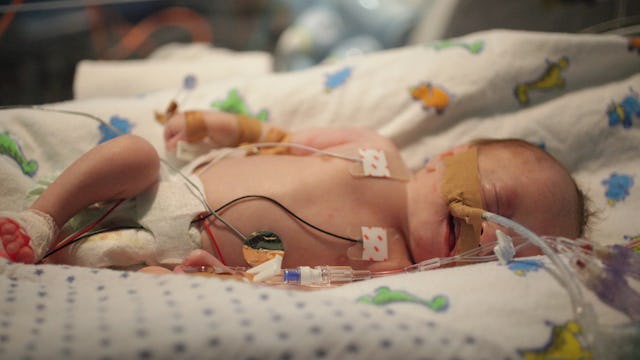Science Is So Close To Helping NICU Parents Enjoy Skin-To-Skin With Their Babies

This amazing medical advancement could help NICU parents get skin-to-skin with their babies
One of the toughest things about having a baby in the neonatal intensive care unit (NICU) is that doctors and nurses need to be monitoring the little one’s vitals at all times. This has long meant that babies who need special care after birth are buried under a heap of wires connecting them to different types of monitors. Not only does this make it nearly impossible for parents to get skin-to-skin contact with their brand new infants, but it can make it tough for doctors and nurses to get good access to the baby to administer care.
All that may finally be changing. Researchers at Northwestern University and the Robert H. Lurie Children’s Hospital in Chicago have developed a new type of wireless sensor that they think will be able to monitor babies with the same level of accuracy as all those wires, without getting in the way of letting parents and doctors get close to the little ones. Finally, NICU parents might be able to enjoy unobstructed skin-to-skin with their babies.
Doctors who worked on the development of the new wireless sensors say the importance of skin-to-skin for a new baby, especially one that’s fighting complications or health problems, was a huge driver for the team.
“It’s been shown to decrease the risk of pulmonary complications, liver issues and infections,” Dr. Amy Paller, who co-lead the study, explained. “Yet, when you have wires everywhere and the baby is tethered to a bed, it’s really hard to make skin-to-skin contact.”
The first study involving the sensors was just published in the medical journal Science, and found by analyzing data from more than 20 premature newborns that the wireless sensors were just as precise and accurate in monitoring vital stats as traditional, wired methods.
And that’s not even the only benefit.
While traditionally, NICU babies would need to be connected to half a dozen or more separate wires, and those wires would have to be taped down to ensure the baby’s movement didn’t jostle them loose, it only takes two of these wireless sensors to monitor all of baby’s important vitals, including breathing, blood pressure, blood oxygen and heartbeat. Plus, they’re super lightweight, which means they’re easier on babies’ sensitive skin.
Image via Northwestern University
“The strength of the adhesive required to keep our lightweight device on the skin is much lower than that of the kinds of adhesives needed to maintain an interface between a hardwired sensor and an external box,” another co-author of the study wrote. “We have seen no adverse side effects in our study, not even a hint of skin injury even in the most frail babies.”
While a medical advancement like this, that has the potential to completely revolutionize NICU care, seems like science fiction, it could actually be right around the corner. The sensors are scheduled to be used in a pilot test program beginning in April, and researchers estimate they could become commonly used in hospitals within two years.
This article was originally published on